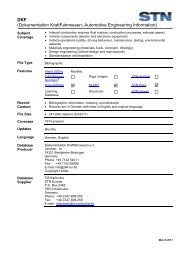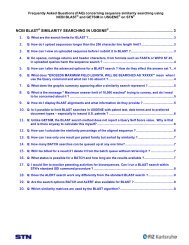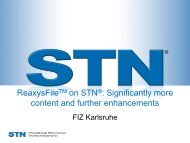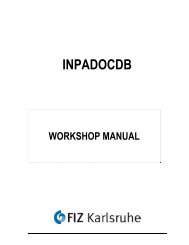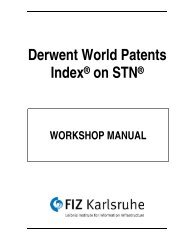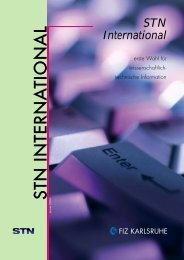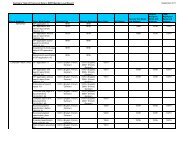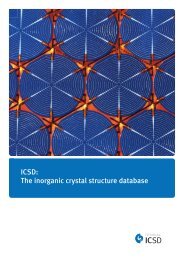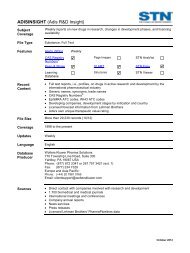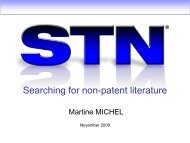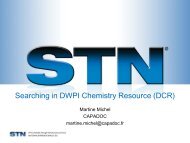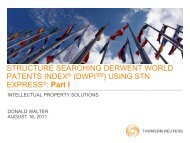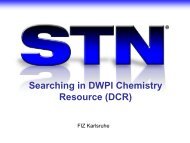note - FIZ Karlsruhe
note - FIZ Karlsruhe
note - FIZ Karlsruhe
Create successful ePaper yourself
Turn your PDF publications into a flip-book with our unique Google optimized e-Paper software.
Introduction to similarity searching<br />
Expectation value (-E)<br />
Expectation value (E-Value) is the statistical significance threshold for reporting matches against a<br />
sequence database. The E-value can be any positive number, and the default value is 10. This<br />
means that 10 matches may be expected to be found merely by chance. In general, the E-value is<br />
lowered to make the search more precise and raised to retrieve more answers.<br />
Peptide similarity matrices (-M)<br />
For peptide-based searches SQP and TSQN, the advanced options provide additional scoring<br />
matrices to the default BLOSUM-62. Guidelines from the NCBI, regarding the use of scoring<br />
matrices for peptide queries of various lengths, are shown in the table below.<br />
Query Length Matrix Gap costs<br />
85 BLOSUM-62 (11,1) (BLAST default)<br />
Decide how many answers to keep<br />
After the BLAST or GETSIM search is completed a candidate answer set consisting of sequences<br />
exceeding a certain similarity threshold 1 is collated. A diagram is generated that shows the scores<br />
of the retrieved sequences. The x-axis represents the number of sequence record answers with a<br />
specific similarity score, and the y-axis is scaled by the corresponding similarity scores. Also<br />
provided above the diagram are the Query Self Score – which is the similarity score of the query<br />
mapped against itself – and the score of the best answer retrieved in the results set.<br />
After assessing the display of the diagram, the whole candidate answer set, a subset of the answer<br />
set, or a subset represented by a minimum percentage of the Query Self Score may be kept. If<br />
only a subset is required, this is specified by answering "How many answers would you like to<br />
keep?" with the either the number of desired records, or the appropriate minimum percentage of<br />
the Query Self Score, followed by the percent sign (%). The candidate answer set may contain up<br />
to 10,000 best scoring candidate sequences.<br />
Sort answers by similarity score<br />
The answer set L-number generated after the search (above), contains sequence records sorted by<br />
descending database entry date. BLAST and GETSIM sequence records may resorted into<br />
descending score order. Just type SOR SCORE D at the arrow prompt. Alternatively, BLAST<br />
search results may be resorted into BLAST identity percentage order, using SOR IDENT D.<br />
Example<br />
=> SOR SCORE D<br />
PROCESSING COMPLETED FOR L2<br />
L3 153 SOR L2 SCORE D<br />
1 For BLAST searches the threshold is defined by the “expectation value”. For GETSIM searches the threshold is an<br />
automatically adjusted function of the query length, query type and database size.<br />
Page 16 | GENESEQ on STN (DGENE) Workshop Manual



